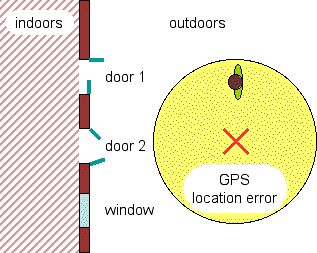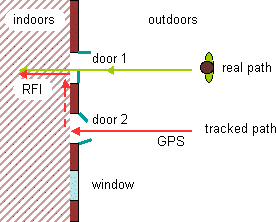- scenarios
- train
- twin doors
twin doors scenarios
basic situation and sensors
We imagine several people going in and out of a building. The people are equipped with tracking devices. GPS outside with an accuracy of around 3m and more accurate RF tags for indoors.
The building's main entrance has two doors and a window (see fig. 1)

figure 1. physical situation
spaces:
- Outside the building - spherical coordinates obtained from GPs location - locally Euclidean
- Inside the building - one space for each room, with boundary mappings obtained from plans and actual measurements. Cartesian coordinate system per room.
- Physical space
- Personal spaces of the people involved
scenario - sudden shifts and walking through walls
Imagine a single person, let's call her Alison. Alison is walking towards the building and enters through door 1. While she is outside the building the GPs tracks her position and reports a location that is closer to door 2 (see figure 2).
When she gets inside the building the RF sensor takes over and her position is now correctly reported as coming through door 1.
Although Alison's real path is continuous there is a sudden jump (dashed arrow) in the measured location.

figure 2. wrong door?
A slight variant could be if Alison's GPS location had her walk into a wall. Even without the interior sensors it would be evident that something was wrong.
issues:
- how to report Alison's location synchronously to other people at this moment
- how to report Alison's location synchronously to devices on Alison and in the environment
- how to report Alison's location to someone or devices requesting the path taken in the future
- in each case, should we report as shift as discontinuous, or should we smooth it out?
- given inaccuracy of GPS should we be reporting Alison's position in a way that leaves the right doorway ambiguous?
- can we use location shift across boundary to recalibrate boundary mapping?
variant scenarios
Alison doesn't walk through door 1, but instead meets Brian, who is about to go out from the building. Brian's location is measured as at door 1, Alison's is at door 2. Although they may be talking, and so share a physical space with one another, they are not regarded as having met by the system.
What if Alison and Brian have bluetooth devices which sense one another's presence (relational space) and report this to the other spaces. How do we deal with conflicting information?